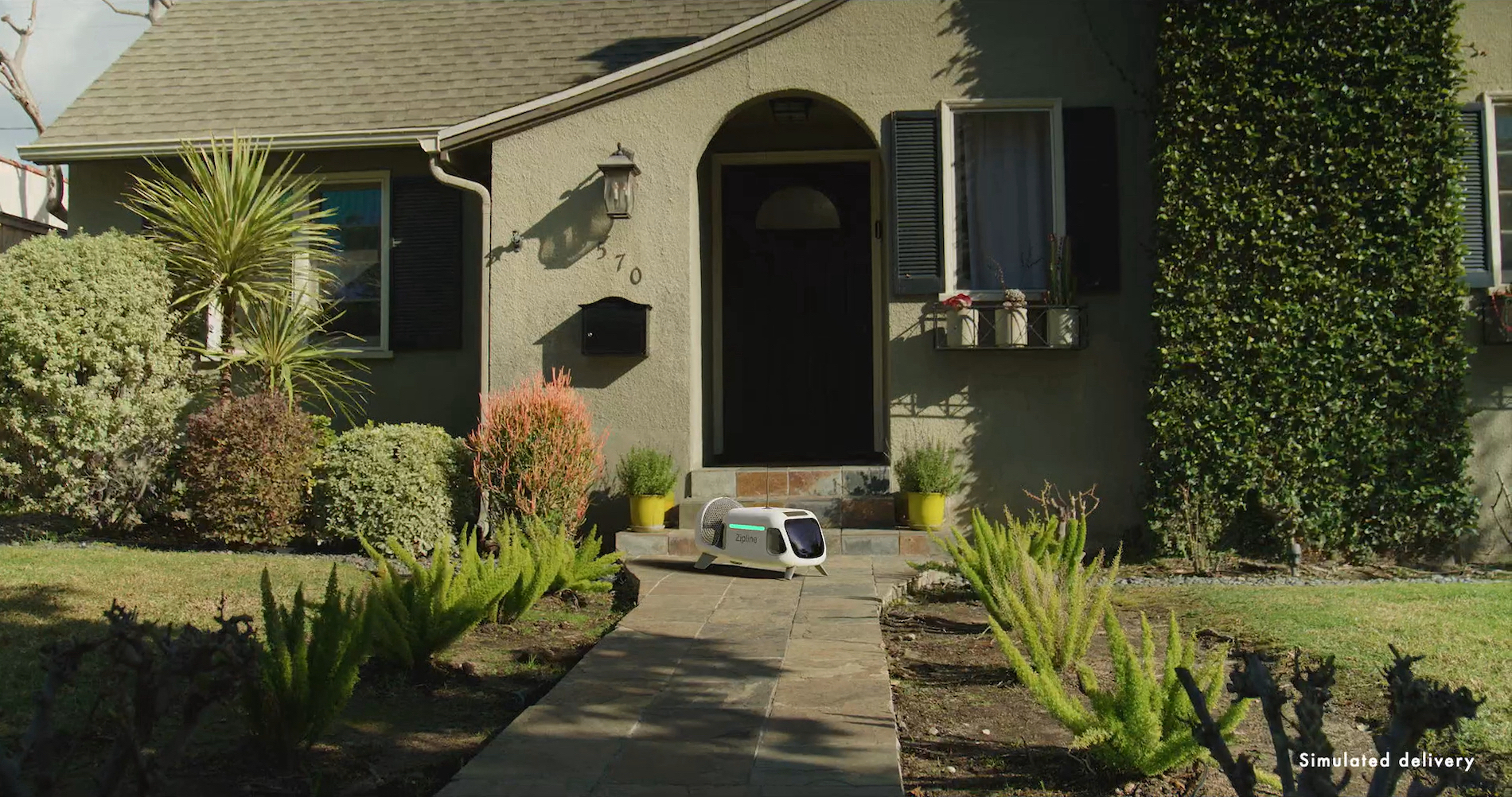

For years, a drone company called Zipline has made deliveries using a fairly traditional approach: An uncrewed aircraft with an 11-foot wingspan drops off a package with a parachute, and it descends to the ground thanks to the predictable presence of gravity. Today, the company announced that they’re working on a new system for drone delivery that’s a bit more tech-forward: They plan to use what they refer to as a “droid” to place a package directly on a target, like a table in a customer’s backyard.
The goal of using this so-called droid—more on how it all works in a moment—is to be able deposit the delivery in a precise way, even if there’s wind. The company refers to this new approach as platform two. (Platform one refers to the parachute approach, which uses a plane that can fly forward but cannot hover in place.) Perhaps, speculates the company’s head of engineering, Jo Mardall, the arrival of a package with this new system will even be a surprise to a customer.
“The core of platform two is really to enable ultra-precise, silent delivery to homes,” Mardall, a former Tesla engineering director, tells PopSci. “I like to think, for platform two, that I might be standing at my back door, turn around to chat to my kids for a second in the kitchen, and I turn back around and there’s a package that’s been delivered to my deck behind me, and I don’t know how it got there.”
During an event today, the company’s CEO, Keller Cliffton, said that the objective for this new home delivery system is for the item to arrive in a way that feels “like teleportation.”

The way the new airborne system works is a bit like a flying mechanical turducken—that infamous culinary creation that involves a chicken within a duck within a turkey. In this case, the package being delivered (the metaphorical chicken) is within the droid unit (the duck), which is nestled into the aircraft itself (the turkey).
The new aircraft has four small rotors and a propeller in the back that can tilt to help it hover. The aircraft makes the delivery from some 300 feet, hovering above the target area. Then, the droid lowers on a tether towards, say, a picnic table. “It lands very briefly—for a second or two,” Mardall says. During that brief landing, doors on the belly of the droid open to deposit the package.
After the delivery, the droid winches back up to the main drone, which is waiting above, and then the aircraft continues on its journey. The aspect of this new approach that is designed to allow for better precision, even during windy days, are thrusters on the droid itself. These thrusters—one electric fan in the rear, and two additional ones in other locations—can blow air to help the mini-drone, which Mardall says is about the size of a gym bag, maneuver.
[Related: Getting rescued by helicopter has risks. This gadget could make it safer.]
“When [it’s] coming down on the winch, if it’s a windy day, we need to have a system to control the location of that droid,” he says. That’s where the three thrusters come into play. “Those thrusters mean that the Zip [the drone mothership above] is just carrying the weight, it’s not having to set the position.”
He adds that because the main drone remains at 300 feet above the target, the whole system is quiet. “This thing is barely audible—just sounds like the rustling of leaves in the trees,” he says.
Aviation engineering typically involves tradeoffs, and this new system is no exception. Their gen-one drones, which resemble small airplanes with a wing, a v-shaped tail, and propellers in the back, have a range of about 50 miles. The new aircraft have the ability to hover and lower a droid, but unlike their predecessors, they have a range of just about 10 miles out and 10 miles back for dropping off an item and then returning from the same place it launched. Or, if the new drone is going on a one-way trip, traveling to a location where it can land and then charge, the range is 24 miles. “You don’t get to cheat the physics here—when you have to hover, hovering is more expensive from an energy point of view,” he says.
The packages this new system can carry can weigh anywhere between 6 and 8 pounds. Mardall says that this year they will be testing the new system in California, and 2024 will see “a pilot delivering to real customers.” They’re aiming for it to be able to deliver items like meals-to-order, meaning that a Sweetgreen salad could theoretically arrive by droid onto a picnic table in someone’s backyard at some point in the future. The company also unveiled a logistics system that can be incorporated into the side of a building, allowing the drones to dock on the outside, and the droid to enter and exit through a small door for loading.
Zipline isn’t alone in the market of delivering items from the sky. One competitor, Wing—from Google’s parent company, Alphabet—just announced a new AutoLoader system and what they’re calling the Wing Delivery Network. Wing’s drones also employ a tether to load and deliver the package, but they do not have a droid.
